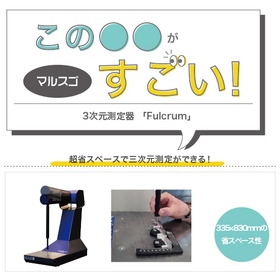Problem-Solving Materials: Utilizing 3D Data Edition 15 | Black/Glossy Work 3D Scan
Easy 3D scanning of black and glossy surfaces! What is the method to effectively reduce post-processing regardless of the performance of the 3D scanner? A resource for discovering and solving challenges in production sites.
This document is a series that proposes solutions to various challenges faced in production sites, from identifying issues to finding resolutions. In the "3D Data Utilization Edition," we will introduce various solutions to manufacturing challenges through the use of 3D data. [Document Overview] With the advent of low-cost and easy-to-introduce 3D scanners, it has become easier to utilize 3D scan data. However, to scan workpieces that have characteristics such as black color or gloss, which are challenging for 3D scanners, it is necessary to use powder spray, which can lead to several inconveniences: - Fine powder can get into gaps. - Careful handling is required to avoid scratching the workpiece. - Since it cannot be washed, it must be wiped off. In this document, we will introduce methods to significantly reduce post-processing time while operating existing 3D scanners! We will provide a detailed explanation of how to complete scans effortlessly, regardless of the performance of the 3D scanner. *You can download the document using the button below.
basic information
■Vol.15 "3D Scanning of Black/Glossy Workpieces" - Characteristics of workpieces that cannot be 3D scanned - How to prepare the target workpiece for recognition? - Challenges when using spray ■Vol.15-1 "Reduction of Post-Processing Steps for Workpieces" - Sublimation spray "AESUB blue" for 3D scanning that requires no post-processing - Shortening the post-processing time for 3D scanning - Are there any residues after sublimation?
Price range
Delivery Time
Applications/Examples of results
Please use this as a hint for those who want to reduce post-processing time after 3D scanning or are considering more efficient operations.
catalog(1)
Download All CatalogsRecommended products
Distributors
【Proposing the latest and standard equipment for manufacturing through a system】 We are the only company in Japan that can provide a comprehensive proposal for all the equipment necessary for manufacturing, including machine tools, CAD/CAM, 3D printers, 3D scanners, and other 3D digital production tools and instruments. 【Peace of mind with technical support after installation】 With our strength in technical support, we can resolve any concerns of users after installation, such as operation assistance, troubleshooting, and maintenance, all through a single point of contact. 【Extensive display of actual machines】 We have various actual machines set up, allowing you to clarify your operational image through demonstrations and tours before making a decision to implement. 【Manufacturer capabilities】 Additionally, if there are no products with the features desired by users, or if there are products with good features but weak sales power, we will leverage our manufacturer capabilities to release them as uniquely planned in-house products.



















































